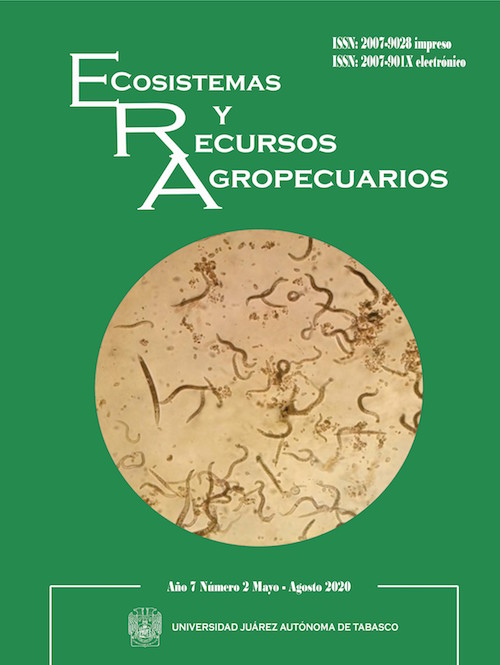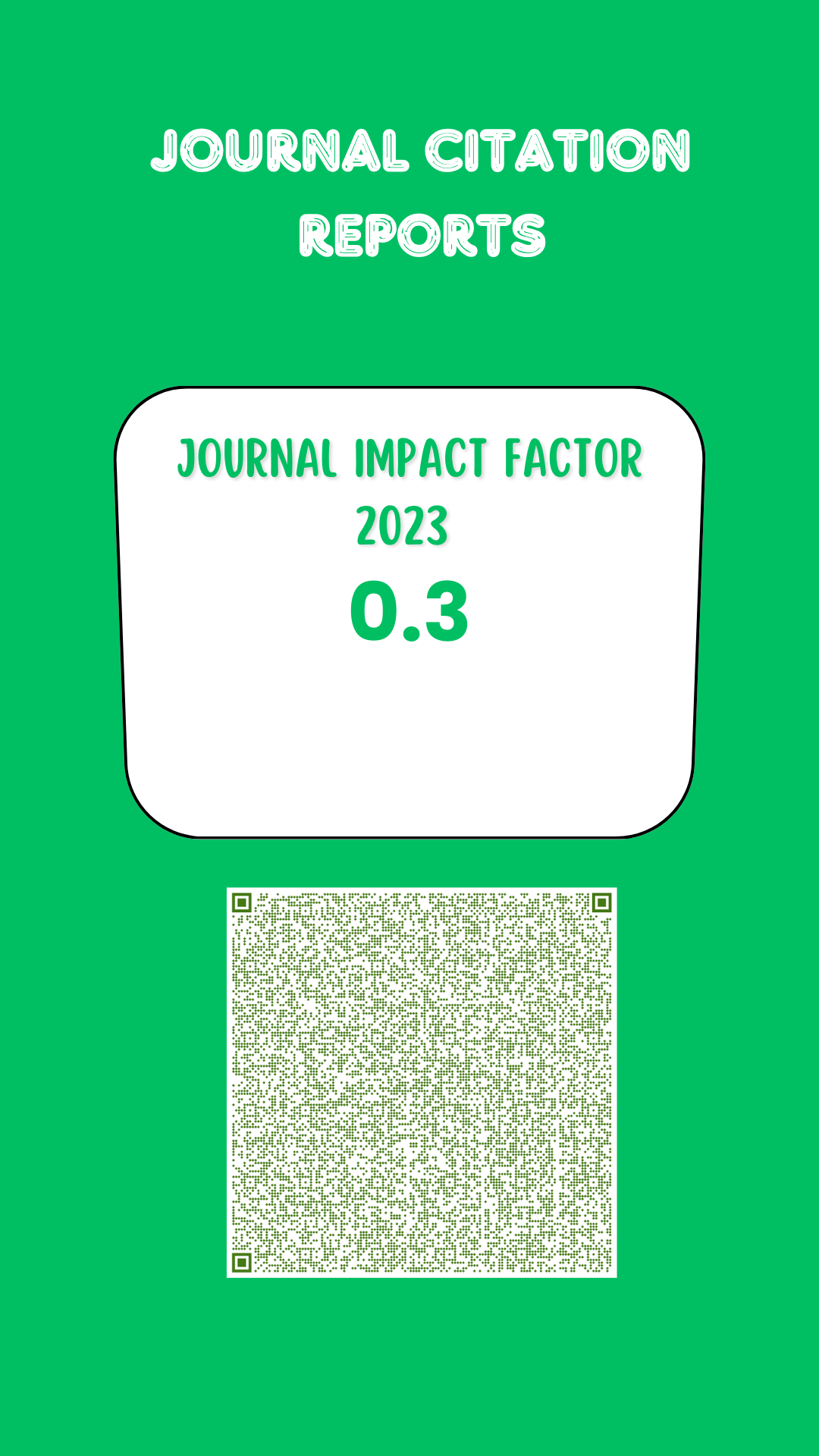Acumulación de metales pesados en alfalfa regada con agua residual de la industria textil
DOI:
https://doi.org/10.19136/era.a7n2.2437Palabras clave:
Crecimiento foliar, Medicago sativa, efluentes residualesResumen
El efluente textil tratado (ETT) tiene uso potencial como agua de riego. El objetivo fue evaluar el efecto de un ETT sobre la acumulación de metales pesados en alfalfa. Se utilizó ETT diluido en agua destilada, a diferentes concentraciones. Como testigos se empleó agua destilada y agua de pozo de uso agrícola. Se evaluó la germinación y acumulación de Cd2+, Pb2+ y Ni2+ en planta y suelo, en un diseño completamente al azar. Se encontró que el ETT sin diluir no mostró inhibición en la germinación. En relación con la absorción de metales pesados, el ETT no generó acumulación en el tejido vegetal ni en el suelo en relación al testigo. Se puede considerar este tipo de efluente una alternativa para el uso de riego del cultivo de alfalfa.Descargas
Referencias
Abunada Z, Nassar A (2014) Impacts of Wastewater Irrigation on Soil and Alfalfa Crop: Case Study from Gaza Strip. Environmental Progress and Sustainable Energy. 00 (00), 1-7. DOI: 10.1002/ep.12034.
Al-Rashdi TT, Sulaiman H (2013) Bioconcentration of heavy metals in alfalfa (Medicago sativa) from farm soils around sohar industrial area in oman. Asia-Pacific Chemical, Biological & Environmental Engineering Society 5: 271 – 278.
Aydinalp C, Marinova S. (2009) The effects of heavy metals on seed germination and plant growth on alfalfa plant (Medicago sativa). Journal of Agricultural Science 15: 347-350.
Azpilcueta-Pérez M, Pedroza-Sandoval A, Sánchez-Cohen I, Salcedo-Jacobo MR, Trejo-Calzada R (2017) Calidad química del agua en un área agrícola de maíz forrajero (Zea mays L.) en la Comarca Lagunera, México. Revista Internacional Contaminación Ambiental 33: 75-83. DOI: 10.20937/RICA.2017.33.01.07.
Begum SA, Alam MJ, Rahman SS, Rahman M (2010) Effect of Industrial Effluents on the Germination and Seedling Growth of Three Leafy Vegetables Bangladesh. Journal of Scientific and Industrial Research 45: 101-104.
Bose S, Bhattacharyya AK (2008) Heavy metal accumulation in wheat plant grown in soil amended with industrial sludge. Chemosphere 70: 1264-1272. DOI: 10.1016/j.chemosphere.2007.07.062.
Cano-Rios P, Figueroa-Viramontes U, Cruz-Martinez JM, Araiza-Escalera IA, Moreno-Reséndez A (2011) Determinación del requerimiento de lavado y fitotoxicidad en compostas y sustratos para la producción en invernadero. In: Agricultura orgánica, cuarta parte. (ed.) Universidad Juárez del estado de Durango, México. pp: 319-332.
Castaldo A, Pariani A, Ferrán A, Giorgis A, Lamela-Arteaga P, Denda S, et al. (2016) Efecto de dos niveles de densidad de siembra y fertilización sobre la producción de dos cultivares de alfalfa bajo corte. Análisis productivo y económico del primer año de producción. Ciencias Veterinarias 18: 8-26 DOI: 10.19137/cienvet-20161821.
Castro E, Mañas P, De Las Heras J (2013) Effects of wastewater irrigation in soil properties and horticultural crop (Lactuca sativa L.). Journal of Plant Nutrition 36: 1659–1677. DOI: 10.1080/01904167.2013.805221.
Chaoua S, Boussaa S, Gharmali A, Boumezzough A (2018) Impact of irrigation with wastewater on accumulation of heavy metals in soil and crops in the region of marrakech in Morocco. Journal of the Saudi Society of Agricultural Sciences DOI: 10.1016/j.jssas.2018.02.003.
Chopra AK, Pathak C (2015) Accumulation of heavy metals in the vegetables grown in wastewater irrigated areas of Dehradun, India with reference to human health. Environmental Monitoring and Assessment 187: 1-8. DOI: 10.1007/s10661-015-4648-6.
CONAGUA (2017) Usos del agua en México. Comision Nacional del Agua. https://www.gob.mx/conagua/acciones-y- programas/usos-del-agua. Fecha de consulta 31 de mayo de 2018.
Coyago E, Bonilla S (2016) Absorción de plomo de suelos altamente contaminados en especies vegetativas usadas para consumo animal y humano. La Granja 23: 35-46. DOI:10.17163/lgr.n23.2016.04.
Dražić G, Mihailović N, Lojić M (2006) Cadmium accumulation in Medicago sativa seedlings treated with salicylic acid. Biology of Plants 50: 239-244.
Elfanssi S, Ouazzani N, Mandi L (2018) Soil properties and agro-physiological responses of alfalfa (Medicago sativa L.) irrigated by treated domestic wastewater. Agricultural Water Management DOI: 10.1016/j.agwat.2018.02.003.
Emino ER, Warman PR (2004) Biological assay for compost quality. Compost Science Utilization 12: 342-348. DOI: 10.1080/1065657X.2004.10702203.
Ganesan S, Chellappan RK (2017) Morphological, biochemical and antioxidant enzyme adaptation of Suaeda maritima growing in textile dye effluent irrigated soil. Indian Journal of Plant Physiology DOI: 10.1007/s40502-017-0317-9.
García-Gallegos E, Hernández-Acosta E, García-Nieto E, Acevedo-Sandoval O (2011) Contenido y traslocación de plomo en avena (Avena sativa, L.) y haba (Vicia faba, L.) de un suelo contaminado. Revista Chapingo Serie Ciencias Forestales y del Ambiente 17: 19-29. DOI: 10.5154/r.rchscfa.2010.02.002.
Ghaly AE, Ananthashankar R, Alhattab M, Ramakrishnan VV (2014). Production, characterization and treatment of textile effluents: A critical review. Chemical Engineering and Process Technology
: 1-18. DOI: 10.4172/2157-7048.1000182.
González-Barrios JL, Villa-Castorena M, Catalán-Valencia EA, González-Cervantes G, Inzunza-Ibarra MA (2013) Geografía de la calidad del agua subterránea para riego en la Comarca Lagunera: conductividad eléctrica. AGROFAZ 13: 119-124.
Hassan J, Kamal MZU, Alam MZ (2013) Impact of textile dyeing effluents on germination and seedling stage of country bean (Lablab niger var. Typicus). International Journal of Earth Sciences 1: 1-9.
He H, Dong Z, Pang J, Wu G, Zheng J, Zhang X (2018) Phytoextraction of rhenium by lucerne (Medicago sativa) and erect milkvetch (Astragalus adsurgens) from alkaline soils amended with coal fly ash. Science of the Total Environment 630: 570–577. DOI: 10.1016/j.scitotenv.2018.02.252.
Hernández-Acosta E, Quiñones-Aguilar E, Cristóbal-Acevedo D, Rubiños-Panta J (2014) Calidad biológica de aguas residuales utilizadas para riego de cultivos forrajeros en Tulancingo, Hidalgo, México. Revista Chapingo Serie Ciencias Forestales y del Ambiente 20: 89-100. DOI: 10.5154/r.rchscfa.2012.03.024.
INEGI (2011) Estadísticas a propósito de la industria del vestido. internet.contenidos.inegi.org.mx/contenidos/productos/prod.serv/.../Vestido.pdf. Fecha de consulta 04 de noviembre de 2017.
Ivy N, Hossain MK, Hossain ML (2015) Effects of industrial effluents on germination and early growth of selected agricultural crops. Agronomy Journal 14: 43-48. DOI: 10.3923/ja.2015.43.48.
Karci A. (2014) Degradation of chlorophenols and alkylphenol ethoxylates, two representative textile chemicals, in water by advanced oxidation processes: The state of the art on transformation products and toxicity. Chemosphere 99: 1-18. DOI: 10.1016/j.chemosphere.2013.10.034.
Khan F, Khan M, Samad A, Noor Y, Rashid M, Jan B (2015) In-situ stabilization of heavy metals in agriculture soils irrigated with untreated wastewater. Journal of Geochemical Exploration 159: 1–7. DOI: 10.1016/j.gexplo.2015.07.002.
Khan M. J., Khan N. U., Khan F., Afzal M. y Jan T. (2016) Effect of amendments on bioavailability of heavy metals to alfalfa and biomass yield irrigated with wastewater. Journal of Environmental Engineering DOI: 10.1061/(ASCE)EE.1943-7870.0001113.
Landero-Figueroa JA, Wrobel K, Afton S, Caruso JA, Gutierrez-Corona JF, Wrobel K (2007) Effect of some heavy metals and soil humic substances on the phytochelatin production in wild plants from silver mine areas of Guanajuato, México. Chemosphere 70: 2084–2091. DOI: 10.1016/j.chemosphere.2007.08.066.
Lara-Viveros FM, Ventura-Meza A, Ehsan M, Rodríguez-Ortega A, Vargas-Montiel J, Landero-Valenzuela N (2015) Contenido de cd y pb en suelo y plantas de diferentes cultivos irrigados con aguas residuales en el Valle del Mezquital, Hidalgo, México. Revista Internacional de Contaminación Ambiental 31: 127-132.
Lyu J., Park J., Pandey L., Choi S., Lee H., De Saeger J., Depuydt S. y Han T. (2018). Testing the toxicity of metals, phenol, effluents, and receiving waters by root elongation in Lactuca sativa L. Ecotoxicol. Environ. Saf. 149, 225–232. DOI: 10.1016/j.ecoenv.2017.11.006.
Mahawar P, Akhtar A (2016) Impact of dye effluent on growth and chlorophyll content of alfalfa (Medicago sativa L.). Annals of Plant Sciences 5: 1432-1435. DOI: 10.21746/aps.2016.10.004.
Malaviya P, Hali R, Shama N (2012) Impact of dyeing industry effluent on germination and growth of pae (Pisum sativum). Journal of Environmental Biology 33: 1075-1078.
Marino MA, Echeverría HE (2018) Diagnóstico de requerimiento de fósforo para alfalfa (Medicago sativa L.) en argiudoles. Agriscientia 35:11-24.
Mohammad A, Khan AU (1985) Effects of a textile factory effluent on soil and crop plants. Environmental Pollution 37: 131-148. DOI: 10.1016/0143-1471(85)90004-2
Nath K, Singh D, Sharma Y (2007) Combinatorial effects of distillery and sugar factory effluents in crop plants. Journal of Environmental Biology 28: 577-582.
Pokhriya P, Punetha D, Arunachalam K, Arunachalam A (2017) Can we use textile effluent as a source of irrigation: A case from Bhagwanpur, Uttarakhand (India). International Journal of Applied Environmental Sciences 12: 527-540.
Ramya S, Kumar RP, Murugesan S, Anitha S (2017) Effect of textile effluent on seedling germination, growth and biochemical characteristics of Arachis hypogaea L. variety K6. International Journal of Pharma Research and Health Sciences 5: 1805-1809. DOI: 10.21276/ijprhs.2017.04.17.
Rehman A, Bhatt HN, Athar HR (2009) Textile effluents affected seed germination and early growth of some winter vegetable crops: A case study. Water Air and Soil Pollution 198: 155–163. DOI: 10.1007/s11270-008-9834-5.
Rekik I, Chaabane Z, Missaoui A, Bouket C, Luptakawa L, Elleuch L (2016) Effects of untreated and treated wastewater at the morphological, physiological and biochemical levels on seed germination and development of sorghum (Sorghum bicolor (L.) Moench), alfalfa (Medicago sativa L.) and fescue (Festuca arundinacea Schreb.). Journal Hazardous Materials 1-28. DOI: 10.1016/j.jhazmat.2016.12.033.
Rodríguez M, Alvarez-Goncalvez CV, Fernández-Cerelli A, Pérez-Carrera A (2016) Efecto del arsénico sobre plantas forrajeras de importancia pecuaria en la Argentina. InVet 18.
Rupa TR, Rao S, Rao S, Singh M (2003) Effects of farmyard manure and phosphorus on zinc transforma- tions and phyto-availability in two alfisols of india. Bioresource Technology 87: 279–288. DOI: 10.1016/S0960-8524(02)00235-3.
SAGARPA (2016). La comarca lagunera, primer lugar en producción de leche, carne de ave y forrajes. http://www.sagarpa.gob.mx/Delegaciones/regionlagunera/boletines/Paginas/2016B071.aspx Fahca de consulta 04 de agosto de 2017.
SE (2001). Norma Oficial Mexicana NMX-AA-051-SC¬FI-2001. Análisis de agua, determinación de metales por absorción atómica en aguas naturales, potables, residuales y residuales tratadas método de prueba. Secretaría de Educación. Diario Oficial de la Feder¬ación. 25 de marzo de 1980. https://www.gob.mx/cms/uploads/attachment/file/166785/NMX-AA-051-SCFI-2001.pdf. Fecha de consulta 24 de agosto de 2017.
SEMARNAT (2003). Norma Oficial Mexicana NOM-001-SEMARNAT 1996. Que establece los límites máximos permisibles de contaminantes en las descargas de aguas residuales en aguas y bienes nacionales. Secretaría de Medio Ambiente, Recursos Naturales y Pesca. Diario Oficial de la Federación. 23 abril 2003. http://www.dof.gob.mx/nota_detalle.php?codigo=5510140&fecha=05/01/2018. Fecha de consulta 15 de octubre de 2017.
SEMARNAT (2007). Norma Oficial Mexicana. NOM-147-SEMARNAT/SSA1-2004. Que establece los criterios para determinar las concentraciones de remediación de suelos contaminados por arsénico, bario, berilio, cadmio, cromo hexavalente, mercurio, níquel, plata, plomo, selenio, talio y/o vanadio. Secretaría de Medio Ambiente, Recursos Naturales y Pesca. Diario Oficial de la Federación. 2 de marzo de 2007. http://biblioteca.semarnat.gob.mx/janium/Documentos/Ciga/agenda/PP03/DO950.pdf 04/11/17-. Fecha de consulta 07 de junio del 2017.
SEMARNAT (2013). Programa nacional hídrico 2014-2018. https://www.gob.mx/conagua/...programas/programa-nacional-hidrico-pnh-2014-2018. Fecha de consulta 05 de julio del 2017.
Singh A, Eapen S, Fulekar MH (2009) Potential of Medicago sativa for uptake of cadmium from contaminated environment. Romanian Biotechnological Letters 14: 4164-4169.
Singh A, Sharma RK, Agrawal M, Marshall F (2010) Risk assessment of heavy metal toxicity through contaminated vegetables from waste water irrigated area of Varanasi, India. Tropical Ecology 51: 375-387.
Tabasi S, Hassani H, Azadmehr AR (2017) Phytoextraction-based process of metal absorption from soil in mining areas (tailing dams) by Medicago sativa L. (alfalfa) (Case study: Sarcheshmeh porphyry copper mine, se of Iran). Journal of Mining Environment. 8: 419-431. DOI: 10.22044/jme.2017.897
Tóth T, Tomáš J, Lazor P, Bajčan D, Jomová K (2009) The transfer of metals from contaminated soils into agricultural plants in high Tatras region. Czech Journal Food Sciences 27: 390–393.
UNESCO-ONU-Agua. (2018). Informe Mundial de las Naciones Unidas sobre el Desarrollo de los Recursos Hídricos 2018: Soluciones basadas en la naturaleza para la gestión del agua. Informe. París, Francia, 168 pp.
Winpenny J, Heinz I, Koo-Oshima S (2013) Reutilización del agua en la agricultura: ¿Beneficios para todos?. http://www.fao.org/docrep/017/i1629s/i1629s.pdf. Fecha de consulta 21 de septiembre de 2017.
Wins JA, Murugan M (2010) Effect of textile mill effluent on growth and germination of black gram Vigna munga (L.) Hepper. International Journal of Pharmaceutics 1: 1-7.
Yahagh Z, Shirvani M, Nourbakhsh F, Pueyo J (2019) Uptake and effects of lead and zinc on alfalfa (Medicago sativa L.) seed germination and seedling growth: Role of plant growth promoting bacteria. South African Journal of Botany DOI: 10.1016/j.sajb.2019.01.006
Yan-Jie G, Cheng-Long H, Jing-Wei F, Xiao-Peng S, Meng K, Xiao-Yan S et al. (2018) Alfalfa forage yield, soil water and p availability in response to plastic film mulch and p fertilization in a semiarid environment. Field Crops Research 215: 94-103. DOI: 10.1016/j.fcr.2017.10.010
Yasmin A., Nawaz S. y Ali S. M. (2011). Impact of industrial effluents on germination and seedling growth of Lens esculentum varieties. Pak. J. Bot. 43 (6), 2759-2763.
Zheng N., Wang Q. y Zheng D. (2007). Health risk of Hg, Pb, Cd, Zn and Cu to the inhabitants around Huludao zinc plant in China via consumption of vegetables. Sci. Total Environ. 383, 81-89. DOI: 10.1016/j.scitotenv.2007.05.002
Zhou P., Yang F., Ren R., Huang B. y An Y. (2014). Phytotoxicity of aluminum on root growth and indole-3-acetic acid accumulation and transport in alfalfa roots. Environ. Exper. Bot. 104, 1-8. DOI: 10.1016/j.envexpbot.2014.02.018
Descargas
Publicado
Número
Sección
Licencia
1. Política propuesta para revistas de acceso abierto
Los autores/as que publiquen en esta revista aceptan las siguientes condiciones:
1. Los autores/as conservan los derechos de autor y ceden a la revista el derecho de la primera publicación, con el trabajo registrado con la licencia internacional Creative Commons Reconocimiento-No comercial-Compartir igual 4.0 .de atribución de Creative Commons, que permite a terceros utilizar lo publicado siempre que mencionen la autoría del trabajo y a la primera publicación en esta revista.
2. Los autores/as pueden realizar otros acuerdos contractuales independientes y adicionales para la distribución no exclusiva de la versión del artículo publicado en esta revista (p. ej., incluirlo en un repositorio institucional o publicarlo en un libro) siempre que indiquen claramente que el trabajo se publicó por primera vez en esta revista.
3. Se permite y recomienda a los autores/as a publicar su trabajo en Internet (por ejemplo en páginas institucionales o personales) antes y durante el proceso de revisión y publicación, ya que puede conducir a intercambios productivos y a una mayor y más rápida difusión del trabajo publicado (vea The Effect of Open Access).

Este trabajo está sujeto a una licencia internacional Creative Commons Reconocimiento-No comercial-Compartir igual 4.0 .



